- Date: 10 Mar 2017
- Comments: (0)
- Categories: For Everyone, Host Communities, Human Interest, Images/Videos, Outreach
Journey Through the Universe 2017
The Universe is expanding… and so is the Journey Through the Universe program! From March 13-17, 70 observatory professionals and informal educators are extending their reach to districts across the Big Island. Journey Through the Universe (to be referred to as Journey in the rest of this post) includes: classroom visits for students in Hilo-Waiākea, Honokaʻa, Paʻauilo, and Waimea in grades 2-12, StarLab Portable Planetarium shows for Hilo-Waiākea students in K-1, workshops for teachers, including a workshop for 40 teachers from the Kaʻū-Keaʻau-Pāhoa Complex area to introduce the Next Generation Science Standards (NGSS) and a NASA Lunar and Meteorite Sample Certification Workshop led by NASA Solar System Exploration Research Virtual Instituteʻs (SSERVI) Brian Day and Joseph Minafra, as well as a public colloquia titled, “Discovery, New Frontiers, and Solar System Exploration,” by NASAʻs Brian Mitchell.
“Sustaining a program the size and magnitude of Journey is no small feat,” says Journey Team Leader Janice Harvey. “With the continual expansion of the Journey program year after year, itʻs obvious that the impact this program has on our local students and the community is substantial.”
Check this post every day during the week of Journey classroom visits for pictures and descriptions of the dayʻs events!
Classroom Visits – Friday, March 17th
On the last day of classroom visits, we followed Gemini astronomer André-Nicolas Chené and administrative specialist Natalia Gonzalez to Kalanianaʻole Elementary and Middle School. Students built 3-D models of well-known constellations and discovered that, although the constellations may look 2-D to us on Earth, each star in the constellation is a certain distance away and are often not right next to each other!
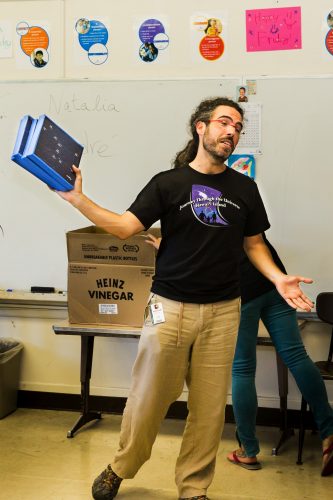
Chené hands out styroform boards with constellations attached.
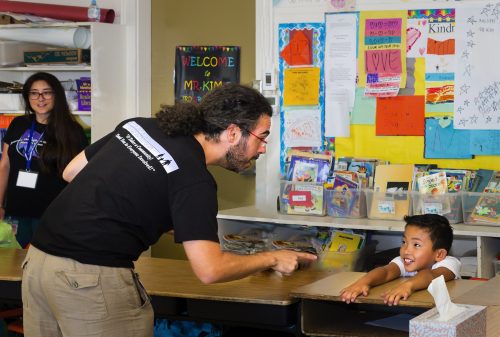
Students answer Chené’s questions.
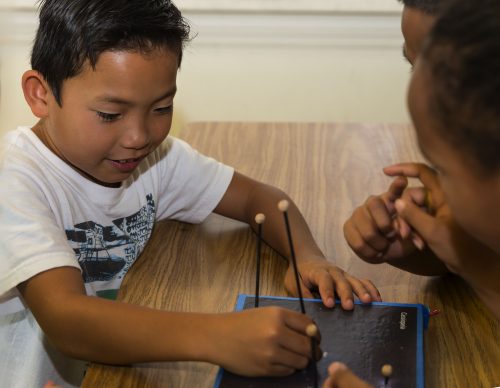
Students construct their own 3D constellations!
Career Panel at Waiākea High School
One of the newer additions to the Journey program is the inclusion of career panels made up of local observatory professionals. Wednesdayʻs panel included: Canada-France-Hawaiʻi Telescope (CFHT) Director Doug Simons and Les Mizuba, Subaru Telescopeʻs Kiaina Schubert, W. M. Keckʻs Mike Aina, and Geminiʻs John Vierra and Alexis Acohido. Thursdayʻs panel included: W. M. Keckʻs Rich Matsuda, Shelly Pelfrey, Leslie Kissner, CFHTʻs Grant Matsushiga, Subaru Telescopeʻs Lucio Ramos, and Geminiʻs Jason Kalawe. Panelists shared how they got involved in working for the observatories and the path they took to get there. The panel included a wide range of careers: astronomers, engineers, human resources, web architects, and more. Students learned that having a PhD in astronomy isnʻt a requirement to working at an observatory, and in fact, astronomers only make up around 20% of an observatoryʻs staff.
Classroom Visits – Thursday, March 16th
We followed Scot Kleinman and Sylvia Kowalski to Keaukaha Elementary School. Kleinman received his PhD from the University of Texas in 1995. Currently, he is the Associate Director of Development at Gemini North, where he helps bring and develop the next generation of instruments to Gemini. Kowalski is the current Public Information and Outreach Intern at Gemini North. She graduated from the University of Washington with degrees in Physics, Astronomy, and Drama.
Kleinman taught the kids how to program and they got to simulate programming the movement of the Mars Rover.

Kleinman explained how Mission Control “talks” to the Mars Rover and tells it what to do.
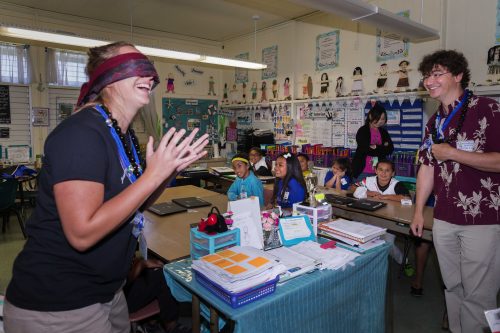
Kowalski (left) played the Mars Rover and the students told Kowalski what to do and where to move.
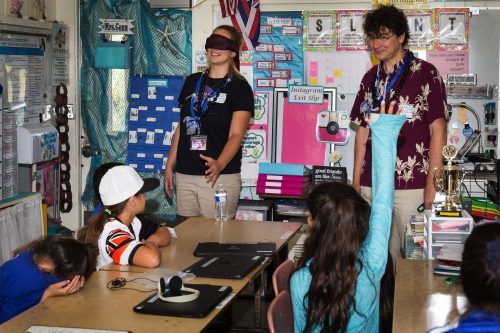
Students attempt to prevent Kowalski from bumping into their desks.
Classroom Visits – Wednesday, March 15th
Yvonne Pendleton and Jennifer Baer of NASA SSERVI visited Kapiolani Elementary School. Pendleton obtained her PhD in astrophysics from the University of California at Santa Cruz and is currently the Director of NASA SSERVI. Baer is a graphic designer at NASA SSERVI and regularly works with scientists and engineers to take complex data and turn it into easily digestible media.
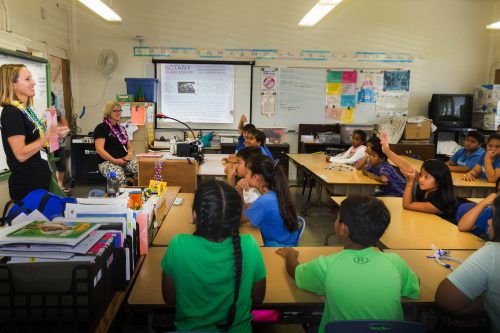
Students at Kapiolani Elementary were surprised and excited that NASA had graphic designers like Jennifer Baer!
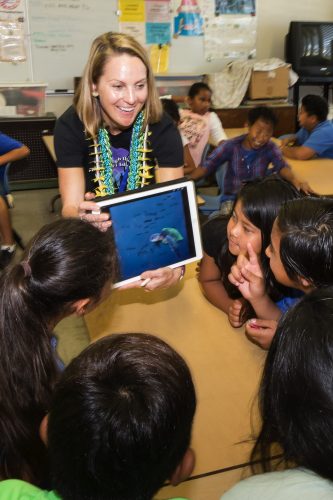
Baer shows students that they can edit pictures with available software.
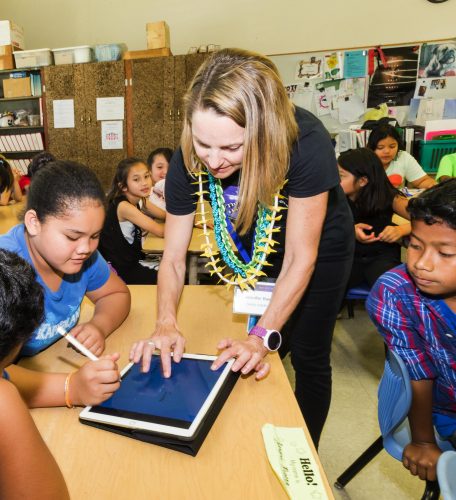
Students practice editing pictures on a tablet.
Discover, New Frontiers, and Solar System Exploration
Wednesday evening, NASA’s Brian Mitchell gave a talk at the University of Hawaiʻi at Hilo about NASA’s current and future vision for planetary exploration. Mitchell has more than 25 years at the Marshall Space Flight Center and has worked on various Space Shuttle payload missions including ASTRO, ATLAS, and Spacelab, as well as several experiments for the International Space Station. Mitchell is currently the Education and Public Outreach manager for NASA’s Discovery/New Frontiers/Lunar Quest Program Office, where he is tasked with communicating Planetary Missions Program Office science goals and objectives to the public in order to promote Science, Technology, Engineering, and Mathematics (STEM) participation.
Mitchell talked about the past and present NASA spacecrafts and the science they were doing at the University of Hawaiʻi at Hilo.
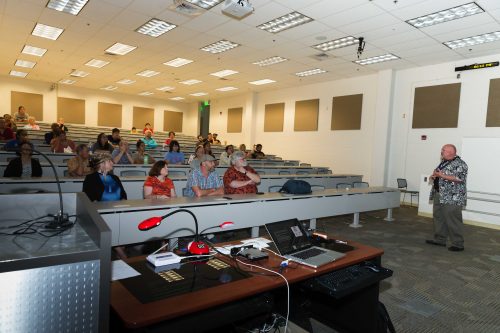
Brian Mitchell (right) presents NASA’s past, current, and future space exploration missions.
Classroom Visits – Tuesday, March 14th
Today we followed Tomonori Usuda to Hilo Intermediate School. Usuda earned his PhD in Astronomy at the University of Tokyo and is an optical-infrared astronomer for the National Astronomical Observatory of Japan. He currently leads the Thirty Meter Telescope (TMT) project as the director of TMT-Japan. Previously, he was the associate Director of Subaru Telescope from 2006-2013.
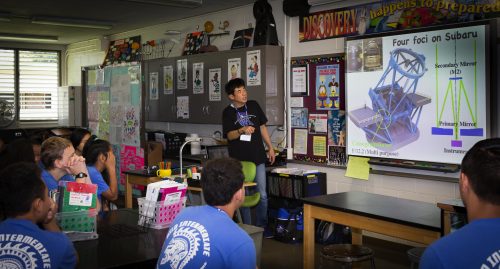
Tomonori Usuda traces the path the light travels to get to the instruments on Subaru Telescope.
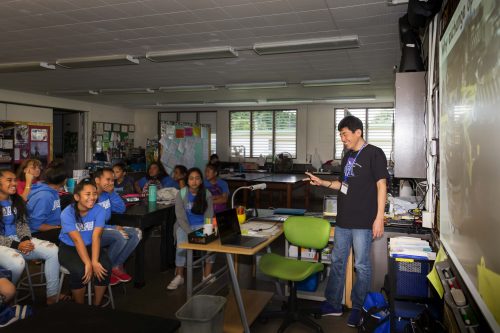
Usuda explains the process behind changing out the instruments on the telescope.
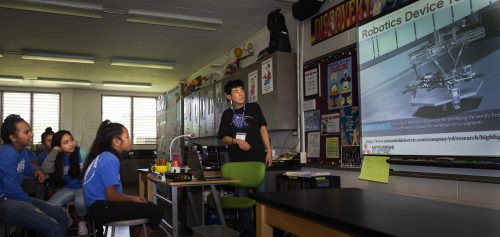
Students recognized the brand name Mitsubishi, but they werenʻt aware that they designed some of the robotics used by Subaru!
Astronomy Educatorʻs Reception at the Naniloa
The Hawaiʻi Island Chamber of Commerce (HICC) and the Japanese Chamber of Commerce and Industry of Hawaiʻi (JCCIH) hosted a welcome celebration for the astronomy community, the Department of Education and the business community. Superintendents from the Hilo-Waiākea Complex, Kaʻū-Keaʻau-Pāhoa Complex, and representatives from the Honokaʻa-Kealakehe-Kohala-Konawaena Complex also attended the event. Guest speakers included: Janice Harvey, Journey Team Leader, Mayor Harry Kim, Gemini Director Markus Kissler-Patig, and PhD candidate and Hilo native Devin Chu. Chu shared his experiences in astronomy and how the Journey program influenced and helped guide his dream of becoming an astronomer.

Mayor Harry Kim addresses the guests at the Astronomy Educator’s reception held at the Naniloa.
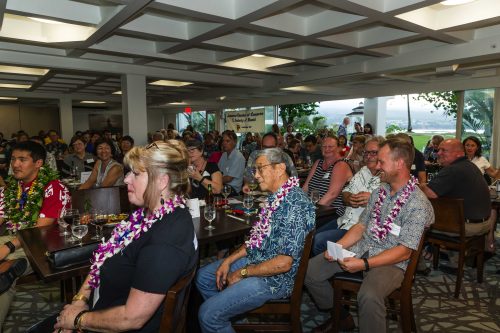
The Naniloa was at capacity, with educators, the business community, and the astronomy community.
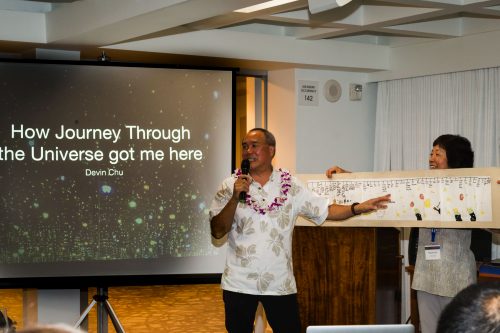
Newton (left) and Roberta Chu (right) introduce their son and guest speaker Devin by showcasing his 3rd grade timeline, which stated that he wanted to be an astronomer since he was 8!

Chu shared his compelling life story about how Journey helped mold his interest and give him direction to become an astronomer.
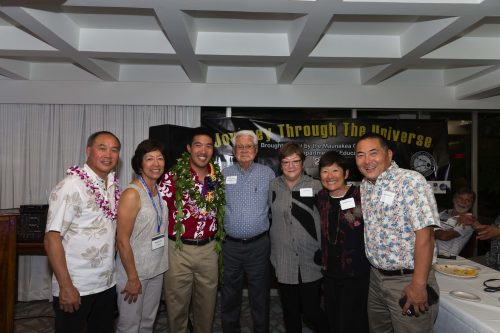
Newton, Roberta, and Devin Chu stop for a picture with other Chamber members.
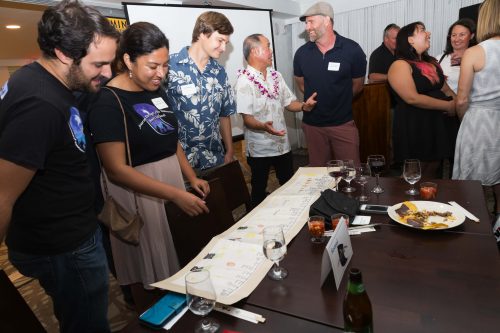
Reception guests take a closer look at Devin Chu’s 3rd grade timeline.
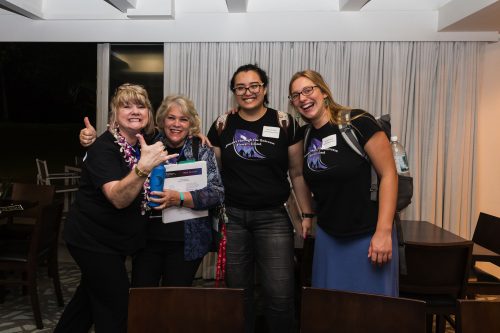
Journey team members from left to right: Janice Harvey, Christine Copes, Alexis Acohido, and Sylvia Kowalski.
Classroom Visits – Monday, March 13th
Our Public Information and Outreach department followed Devin Chu to Hilo Intermediate School and Teague Soderman to Kaumana Elementary School. Chu was born and raised in Hilo, Hawaiʻi and graduated from Hilo High School in 2010, where he was an ongoing participant in the Journey Through the Universe program He received his Bachelorʻs in Physics and Astronomy from Dartmouth in 2014, and his Masterʻs of Science in Astronomy from UCLA in 2016. He is currently working towards his PhD at UCLA while working under Andrea Ghez.
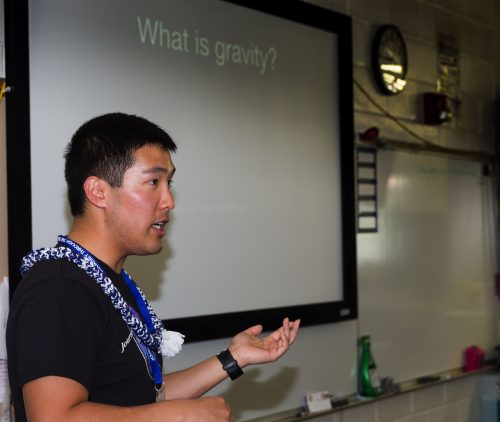
PhD candidate and Hilo native Devin Chu went back to Hilo Intermediate to talk to students about gravity.
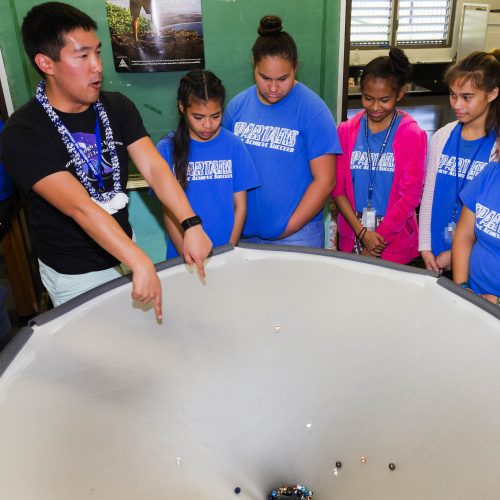
Chu demonstrated how celestial objects move using a “gravity well,” a simulation of a point of strong gravitational pull.
Soderman, who currently works at NASAʻs SSERVI, is a science writer with a background in creative writing and graphic design. He received his Masterʻs in English and Creative Writing from San Francisco State Univesity, and has been writing for the scientific community for over 13 years.
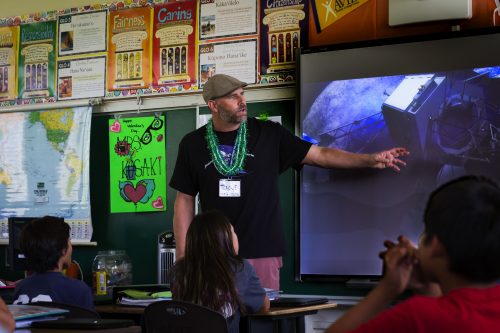
Teague Soderman from NASA SSERVI showed Kaumana students some of the technology that NASA has sent to space.
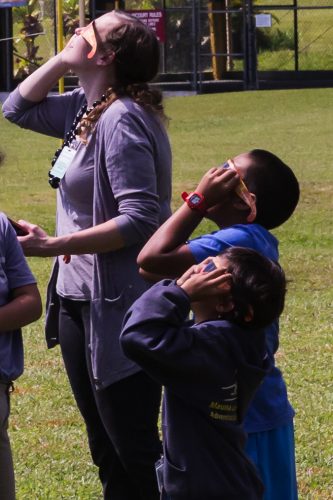
Kaumana students and their teachers look at the Sun through special lenses that protect their eyes.
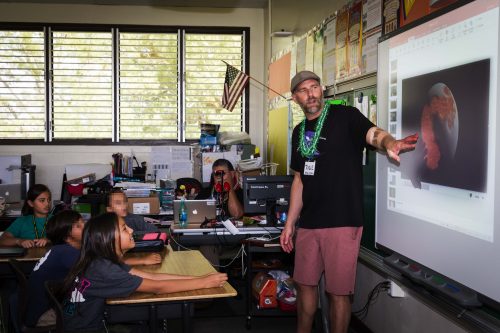
Soderman showed some of the mapping software available online through NASA SSERVI.
NASA Lunar and Meteorite Sample Certification Workshop
On Saturday, March 11th, Brian Day and Joseph Minafra, both from NASA SSERVI, held a workshop that certifies teachers to borrow lunar and meteorite samples from the historic Apollo missions. Teachers attending this workshop will also learn how to use NASA online tools to explore and visualize the surfaces of the Moon, asteroids, and Mars as seen through the eyes of many different instruments aboard a great range of spacecrafts.
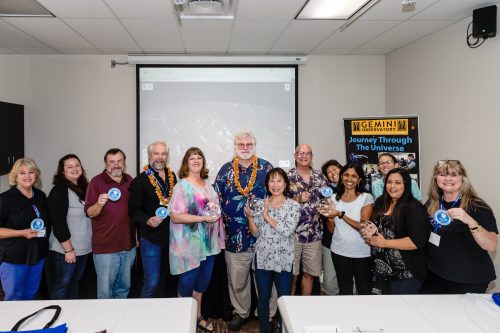
NASA SSERVI’s Brian Day (six from the left) and Joseph Minafra (four from the left) led 10 teachers through a workshop that certifies them to borrow lunar and meteorite samples as teaching tools.
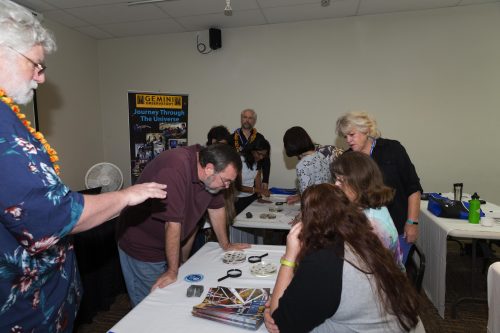
Brian (left) explains how these samples may be used in the classroom.
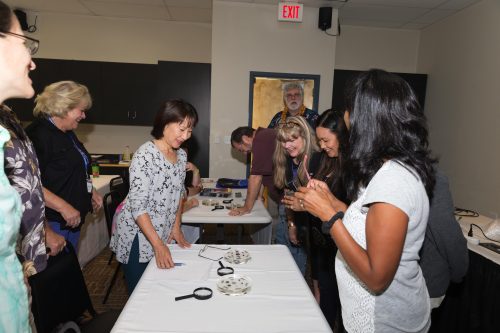
Educators had plenty of time during the all day workshop to examine the samples.
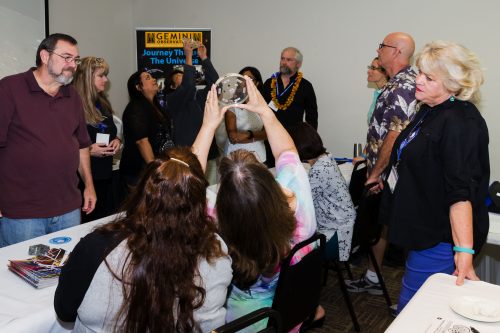
The samples provided contained lunar rocks harvested from the historic Apollo missions.
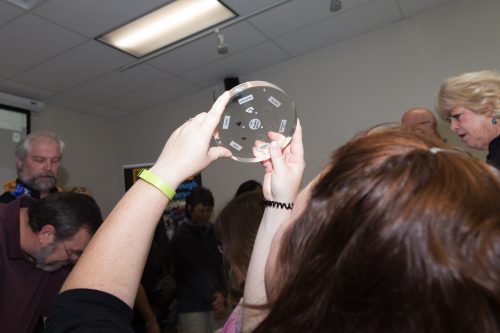
One teacher holds up the sample plate for a better look.
Exploring the StarLab Moon Cylinder
On Thursday, March 9th, Gemini staff and NASA SSERVIʻs Brian Day explored Geminiʻs newly acquired Moon Cylinder before Day held a StarLab presentation for the after school group Perpetuating Unique Educational Opportunities (PUEO). Day currently acts as SSERVIʻs project manager for NASAʻs Lunar Mapping and Modeling Portal, which is a set of tools designed for mission planning, lunar science, and public outreach. Students learned about geological features and phases of the Moon, as well as past and current NASA Moon missions.
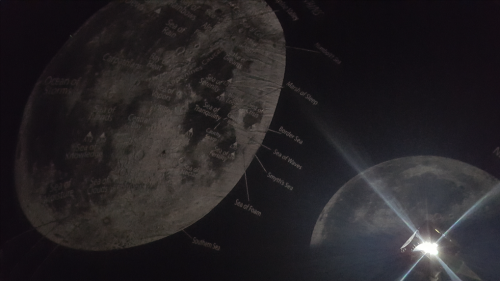
The projection of the Moon in the StarLab maps beautiful features like Moon craters and mare.
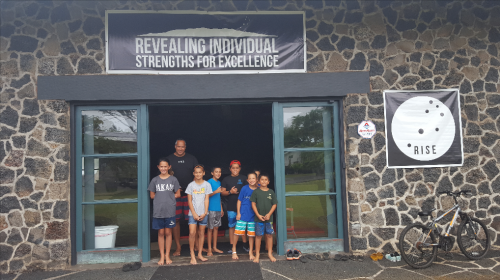
President of PUEO Keahi Warfield and the after school PUEO students.
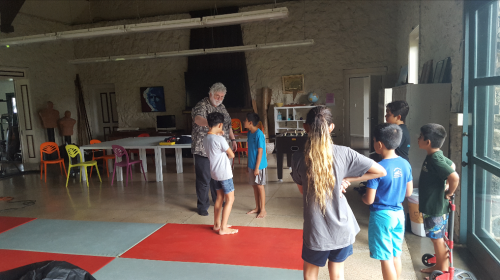
NASA SSERVIʻs Brian Day directs students on modeling the movement of the Moon around the Earth.
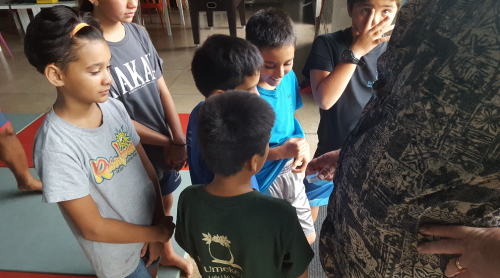
The students held actual lunar rock samples that Day had brought.
Acknowledgements
The Journey program would not exist without the time, energy, and resources from our community partners. Their ongoing support is a testament to their commitment to our children’s futures. We’d like to thank our sponsors for their support, and our educators for dedicating their time to inspiring our local Big Island students! For more information about the Journey Through the Universe program, visit our website.
Thank you to the following institutions!
Department of Education Hilo-Waiākea Complex Area
Department of Education Honokaʻa-Kealakehe-Kohala-Konawaena Complex Area
Department of Education Kaʻū-Keaʻau-Pāhoa Complex Area
Caltech Submillimeter Observatory
Canada-France-Hawaiʻi Telescope
Franklin Institute Science Museum
Hawaiʻi Electric Light Company
Hawaiʻi Island Chamber of Commerce
Hawaiʻi Island Economic Development Board
Hawaiʻi Space Grant Consortium
Indigenous Education Institute
James Clerk Maxwell Telescope Operated by East Asian Observatory
Japanese Chamber of Commerce and Industry
Maunakea Astronomy Outreach Committee
Maunakea Visitor Information Station
NASA Infrared Telescope Facility
National Center for Earth and Space Science
National Optical Astronomy Observatory
National Radio Astronomy Observatory
Pacific International Space Center for Exploration Systems
Smithsonian Submillimeter Array
University of California Observatories – Lick Observatory
University of Hawaiʻi at Hilo, College of Pharmacy
University of Hawaiʻi Hōkū Keʻa and 2.2 Meter Telescopes
University of Hawaiʻi Institute for Astronomy
United Kingdom Infrared Telescope
University of California – Berkeley
University of California – Los Angeles





